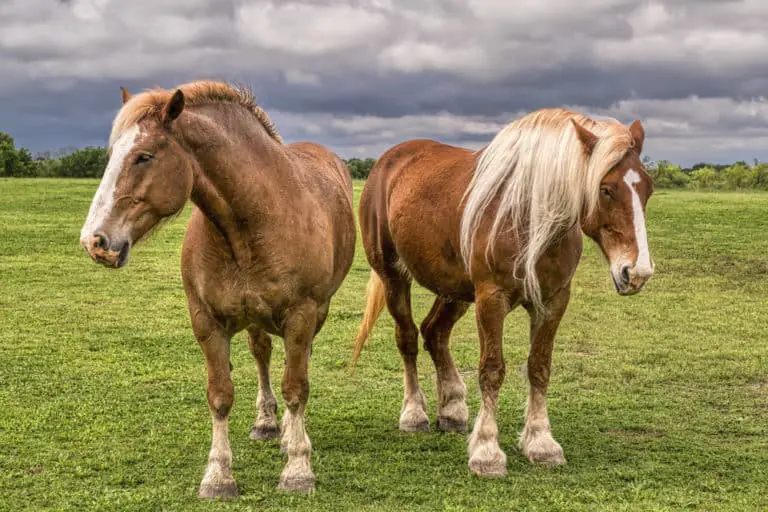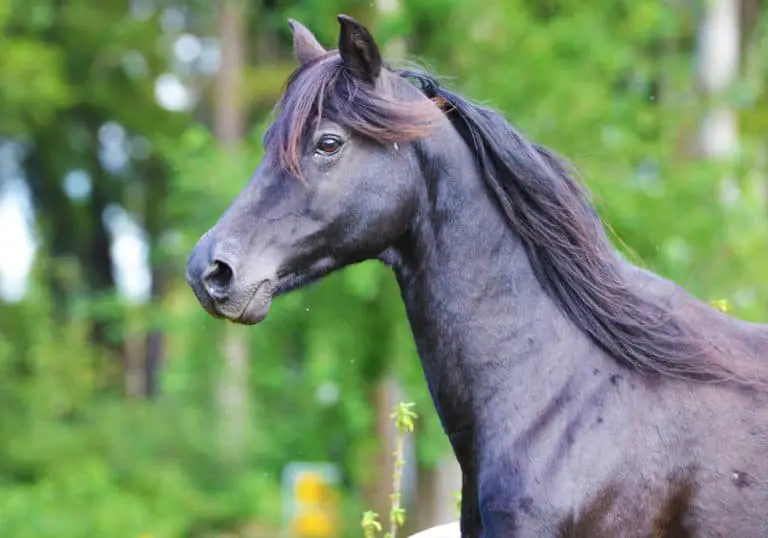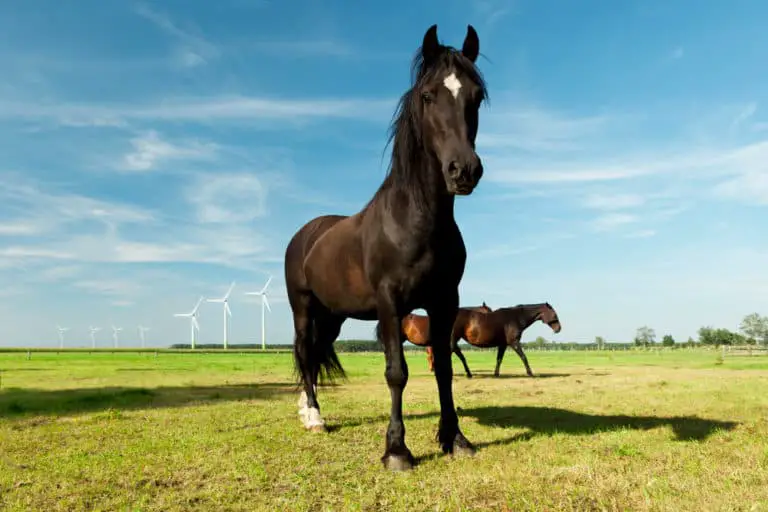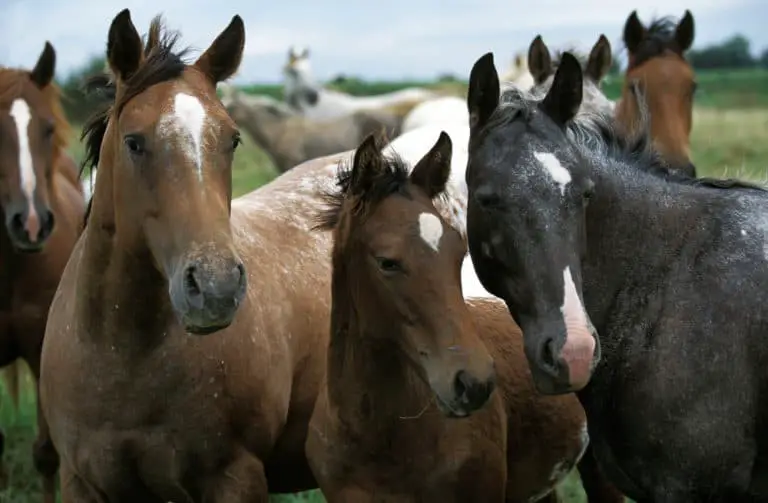Clydesdale Horse Breed: Care, Cost & History (2025)
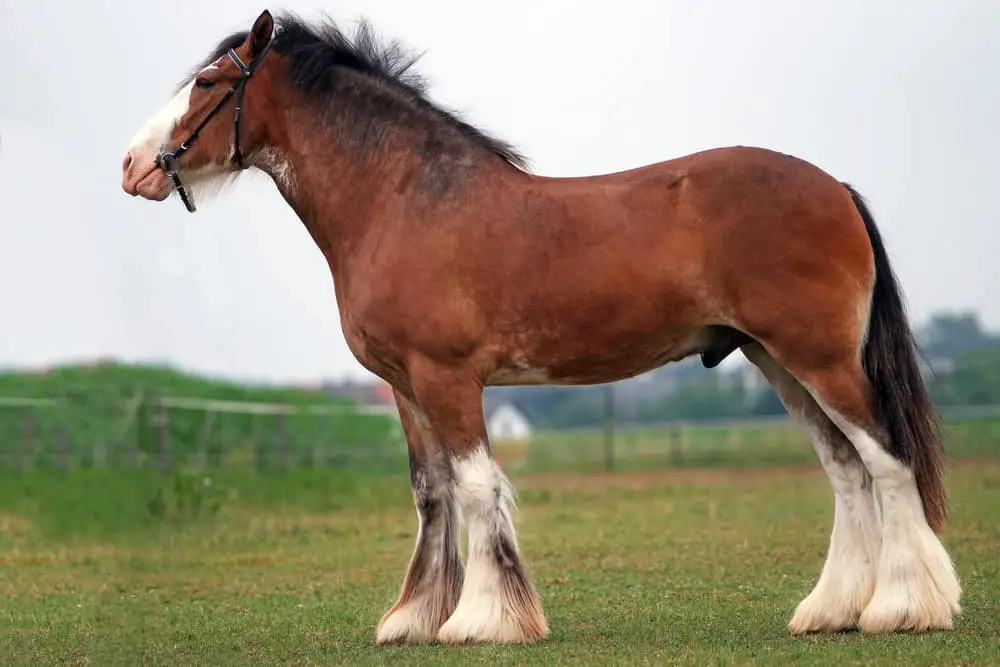
The Clydesdale horse has become an American icon, synonymous with Budweiser beer. The breed has much to offer, with their flashy good looks, strength, and easygoing personalities making them a favorite of equestrians and the general public. They originated in Scotland and were popular workhorses for generations before transitioning to a pleasure role.
Breed: Clydesdale horse
Adult Weight: 1,600-2,400 pounds
Adult Height: 17-18 hands (68-72 inches)
Origin: Scotland
Use: Draught, show
Colors: Bay or brown with white markings
Features: Silky, feathered legs, stylish movement
Lifespan: 25-30 years
Character: Gentle, with noble features and a willing attitude
Gait: Stylish gaits that are powerful and cadenced
Best for: All levels of riders
- Characteristics
- Clydesdale Horse Care
- Clydesdale Horse History
- Modern Clydesdales
- Cost and Ownership
- Buying a Clydesdale
- Similar Breeds
Clydesdale Horse Characteristics
The Clydesdale horse characteristics of today aren’t what they were in earlier times. Today’s horse is strong and muscular, with a neck that elegantly arches out of a sloping shoulder. The Clydesdale horse head is broad in the forehead and muzzle with large, wideset eyes. Their legs are straight and the hooves are the size of a dinner plate.
Size
Modern Clydesdale horse height is taller than the breed originally was, with horses standing between 16 and 18 hands. There are members of the breed, especially stallions, that easily top 18 hands. (1) They are one of the tallest horse breeds, with only Shires, their British neighbor, being taller.
A Clydesdale foal is about nine hands tall, or three feet at the withers when it is born. They grow each year until reaching their full height around age four, and full maturity at age six.
Clydesdale size increased in the 1940s. Breeders wanted taller, flashy horses that could be used in parades and shows. They went from being one of the smaller draft horse breeds to one of the tallest.
Weight
Clydesdale horse weight is between 1,600 and 2,400 pounds, with weight being dependent on height. Although they are taller than most of the other draft horse breeds, they weigh less, being a leaner, more athletic body type. This was again by design, breeders wanted a flashy horse for parades and shows.
A Clydesdale stallion will weigh more than a mare, and foals weigh between 110 and 180 pounds, with 150 pounds at birth being average.
Their bone structure allows for energetic gaits and lively action in the legs – perfect for any parade. The sloping shoulder and hip help elevate the knees and hocks. The hock bone is pointed and pronounced, otherwise the legs bones are flat and clean.
Colors
The beautiful Clydesdale horse is usually bay in color. A white blaze on the face and white socks on the legs are also common. The bay color with white markings is preferred by many, so breeders have tried to produce more horses with this color. They also garner higher purchase prices.
White spotting, usually on the underside of the belly, can also occur. Other Clydesdale horse colors are black, grey, and chestnut.
Sabinos can also occur, but it’s among the rare Clydesdale horse colors, along with black. The sabino coat color pattern where the horse has white legs, a white blaze, and white ticking in their mid-section, making them appear like a white Clydesdale horse.
Temperament
Draft horses like Clydesdales are called cold-blooded horses, and this influences their temperament. Clydesdale horse temperament is considered calm, affable, not prone to spooking, and highly intelligent.
Many people feel like they know the Clydesdale horses because of the Budweiser commercial, showing gentle horses with big hearts. This is an accurate depiction of the breed.
Since modern horses were bred for parades and shows, the Clydesdale horse behavior is also animated and spirited, while still kind and controlled. They have a happy spark that makes them shine in front of crowds.
The breed does not have its own set of rules with the United States Equestrian Federation, and instead uses the general rules, therefore, children cannot exhibit stallions. (2)
Clydesdale Horse Care
Clydesdales aren’t high-maintenance horses but do require daily care. They are smart horses, and you may need to double lock doors and gates to keep the horses from opening them.
A horse is a long-term commitment, the Clydesdale horse lifespan is between 25 and 30 years. Horses’ care includes their diet and nutrition, health care, grooming, and exercise.
Diet and Nutrition
A healthy diet is essential for horses, the same way it is for humans. Equine diet and nutrition include hay and grass, also referred to as forage, grain, and nutritional supplements.
Plenty of clean, fresh water is the most essential nutrient for all horses. The Clydesdale horse breed requires more feed and water than other horses because of their larger size. (1)
Equine owners should work with their veterinarian or an equine nutritionist to make sure the Clydesdale diet is balanced.
Veterinarians recommended that horses consume 1.5 to 2.0% of their bodyweight in forage daily. (3) The horse’s age and amount of work will change this, and horses in heavy work often require grain too. (3)
Health Problems
Unfortunately, the Clydesdale breed does have some health problems. First, the pink skin under the white hair, especially on their faces, can sunburn.
They can also develop a skin itch, thought to be a type of mange, under the heavy feathers on their legs. It’s worst in the pastern area and careful grooming and cleaning can help prevent the “Clydesdale itch” as it’s called. (4)
Genetic problems are limited to chronic progressive lymphedema. It’s more prevalent in draft horse breeds and causes leg swelling.
Left unchecked, it causes permanent scar tissue. Symptoms are that horses stamp their feet and rub their legs trying to relieve the pressure. While there isn’t a cure, progression can be slowed. (5)
Grooming
Clydesdale grooming is a daily occurrence to maintain the horse’s beautiful coat and health. Grooming involves a curry comb to stimulate the oils in the skin, a dandy or stiff brush, a finishing brush, a hairbrush, and a hoof pick. (1)
Most Clydesdale horse owners use a step stool to ensure they are reaching all parts of their horses.
The hooves need to be cleaned daily, and frog health should be monitored for any signs of deterioration. (6) Check for “Clydesdale itch” and clean the pastens at the same time as the hooves. (4)
The Budweiser Clydesdale hitch as grooms whose only job is to ensure the horses are groomed and looking their best. (7)
Clydesdale Horse History
Clydesdale horse history is filled with ups and downs, then a triumphant return to popularity and worldwide fame. The breed began in the mid-1700s in Scotland, and careful breeding developed their distinct characteristics.
Horses were exported throughout the world as workhorses. Mechanization changed how horses were used, but the breed found a new recreational role.
Origin
Flemish stallions were taken up to the River Clyde area of Scotland to improve the horses locals owned. They started recording pedigrees and Clydesdale horse origin in the early 1800s. In 1826, the term Clydesdale was first used. Clydesdale societies formed in the United Kingdom in 1877 and in America in 1879.
The Clyde style horse was shown at local events, and stallions selected as the best then traveled through the area and bred mares. Early uses were in agriculture and hauling coal and heavy transport in the Lanarkshire area. Thousands of horses were exported throughout the world for similar work, with over 20,000 leaving Scotland in a 63-year period that ended in 1945.
Historic Development
Today, the Clydesdale may be known as the Budweiser horse breed, but their development begins before their association with the beer company. Clydesdales were originally shorter, heavier horses, bred for their work hauling coal or in agricultural fields.
Thousands of horses served in World War I, and many lost their lives. Breed numbers dropped significantly after World War II; people didn’t need horses so weren’t breeding them. There were less than 900 mares in the United Kingdom by 1975.
Meanwhile, they were popular in Australia, developing that country’s infrastructure. Breeders in America started developing taller, lighter horses. Then, in the 1990s, worldwide population numbers started increasing again.
Notable Clydesdale Horses
The most famous Clydesdale horses are the Budweiser Clydesdales, who have been pulling a hitch for the Anheuser Busch Company since 1933. The Clydesdale horse pedigree is fit for royalty though and they’ve made appearances with several members of the British royal family over the years, from Queen Victoria to William and Kate.
Blaze
Blaze was an English coach horse that was taken up to Scotland and is one of the founding stallions used in developing the Clydesdale breed. Coach horses were fancier than other drafts, and his name gives us some idea of his looks. One has to wonder how much today’s Clydesdale horses resemble Blaze.
The Budweiser Horse Hitch
There are at least 170 horses owned by the Anheuser-Busch Company, and the entire hitch is famous. These horses live like royalty and continuously wow the crowds. A horse must be a Clydesdale gelding to be in the hitch. Mares and stallions stay on the farms. The first hitch was a gift to celebrate the end of prohibition.
Digger – The Queen’s Clydesdale
Digger was 19.3 hands and 2,000 pounds when he joined Queen Elizabeth’s Cavalry in 2010. He was orphaned at a few weeks old and had health challenges from growing so fast. Digger was with a rescue organization before joining the royal stables. He lived out his life peacefully on one of the Queen’s country estates.
Myths and Legends
Clydesdale horse legends have made the ultimate sacrifice on battlefields, delivered presidential Christmas trees, and learned to play football. This breed really does do it all – and these are just a few of the myths and legends surrounding the breed. Their recent contributions are well-known, but their work during World War I certainly deserves greater recognition.
Unsung Heros
The Clydesdale horses were the unsung heroes of World War I. They pulled the ammunition and guns and suffered severe casualties throughout the war. Cavalry horses received a lot of hype, but soldiers say that without Clydesdale, the war effort would have been lost. Over eight million horses of all breeds were used during World War I.
Presidential Pageantry
Clydesdale horses are part of the presidential pageantry. Presidents Truman and Clinton had Clydesdale horses in their inauguration parades. But it’s the magic of a Christmas tree that has made their presidential connection legendary. Presidents Obama and Trump had the White House Christmas tree delivered by a pair of Clydesdales pulling a red and green wagon.
Playing Football
The Budweiser Clydesdales’ first Super Bowl commercial was in 1986, but they raised the bar in 1996. That year, the commercial featured two teams of Clydesdales playing football against each other in a snowy mountain field. The horses trained for months prior to filming, and 95% of what is in the commercial is actually the horses playing football.
Modern Clydesdale Horses
Clydesdale horses moved from endangered status to at risk, as their role as show and parade horses further solidified. The modern types of Clydesdale horses are used for riding and driving, as well as agricultural work and logging. Their tall frame, smart gaits, and flashy good looks have endeared them to a whole new generation of equine enthusiasts.
Breeding
Clydesdale breeding is primarily found in the United Kingdom, United States, Canada, and Australia. There are small breeders in Russia, Germany, Japan, and South Africa as well.
Show and parade are the two primary Clydesdale horses breeding, with the taller, leaner bloodlines of the United States being the most popular.
Breeders like Anheuser-Busch help continuously improve the bloodlines and provide horses for other breeders as well. Their Warm Springs Ranch in Missouri welcomes visitors for tours while raising the next generation of Clydesdale hitch stars.
The bay and black color with the white blaze and four white legs is still highly sought after and a focus for breeders.
Population
The Clydesdale horse population continues to recover, although it’s still considered threatened. Today, there are around 5,000 members of the breed total, throughout the world. Of this number, 80% of the horses are in either the United States or the United Kingdom. (8)
Unfortunately, the United Kingdom exported thousands of horses and then lost thousands more during the war, devastating their horse numbers.
Their increasing popularity and fame associated with the Budweiser hitch have helped grow numbers to 600 new foals registered per year in the United States. (8) Breed associations in Canada, New Zealand, and Australia is also working to increase the population.
Uses
The snappy Clydesdale horse gait with the flowing white feathers augmenting each step creates a beautiful image at any noteworthy event. It’s no wonder the breed is popular with presidents and members of the royal family, they portray all the best features people want to see in themselves.
Clydesdale horse uses still include their original use of agriculture, logging, and pulling carriages. Today, those carriages might be for tourists visiting a city or dignitaries in a parade.
They are also popular riding horses in the show ring or on a trail ride. Most have a calm disposition and are easy to train. Other uses are evolving, we know they play football, who knows what might be next.
Clydesdale Horse Prices
Owning a horse is expensive, especially when that horse is a draft. The Clydesdale horse price includes the initial purchase price, and then the additional ownership fees. Think of it like buying a house, once you have the house, you still need furniture, food, and annual maintenance costs. These are all essential and must be budgeted for.
Purchase Price
The average purchase price of Clydesdale horse is anywhere from $1,000 to $25,000 although between $2,500 and $5,000 is most common. Bay and black horses with a white blaze on their face and four white socks cost more.
In the United States, some people believe this is the only color a Clydesdale can be since they are used to the Budweiser hitch’s standards. (9)
Clydesdale horse training that includes riding and driving will further increase the base price of a horse. The most expensive Clydesdale horse to date cost $212,500, the horse had been on the cover of the Draught Horse Journal in a hitch, and the sale was in 2011.
Ownership Costs
The Clydesdale horse cost of ownership adds up quickly, expect to pay between $1,770 and $12,930 each year for your horse. This is in addition to the initial purchase. The total depends on your geographic location, the type of board your horse has, what your horse needs, and how much grass is available.
Most of us only think about the purchase price before we invest in something new. But the full Clydesdale price includes the ownership costs each year, for the entire lifespan of the horse, or until you sell them. While these costs do add up, owning a Clydesdale is fun and rewarding.
Board
Clydesdales – and all horses – need protection from the elements and a safe place to move around. Paying for this barn or shelter and pasture is called board. Clydesdale horse board cost can be anywhere from $1,200 to $7,200 per year, depending on the facility and amenities. Clydesdales need more space than other horses because of their size. (10)
Feed
A Clydesdale needs 25-50 pounds of hay each day, this feed provides their diet and nutrition. Working horses also need between two and 10 pounds of grain daily. Grass can be used to supplement hay. Clydesdale horse feed cost is $250 to $4,380 per year, usually on the higher side. (10)
Veterinary Care
Horses need routine veterinary care as both a preventative measure and to identify health issues before they become untreatable. Clydesdale horse veterinary cost is $250 to $350 per year, and this includes vaccinations, dental care, and deworming. Any injuries or medical issues will have an additional cost, up to as much as $1,000. (10)
Hoof Care
Those hooves need maintenance and protection by a farrier. Expect to pay $120 to $1,000 annually for the hooves to be trimmed and for shoes if necessary. The Clydesdale horse hoof care cost ensures the horse has healthy feet that are trimmed every six to eight weeks, which helps prevent lameness and other issues. (10)
Buying a Clydesdale Horse
Love, at first sight, is a wonderful premise, but don’t use it when buying a horse.
People fall in love with the Clydesdale breed because they are beautiful horses, but each has unique talents and personalities.
First, identify what you are looking for in a horse, and then go and meet multiple horses before choosing one.
Is the Clydesdale Horse Right for You?
The Clydesdale horse is perfect for people who want to drive their horses in parades, compete in shows, ride, or need a workhorse. Owning a Clydesdale can be for anyone – the breed is versatile.
These intelligent horses are easy to train (football, anyone) and enjoy being around people. They are also gentle and beginners can be successful with a Clydesdale if it’s already trained.
Riding a Clydesdale horse captures their power and high-stepping gaits in a smooth, ground-covering ride. Horses are responsive to their riders and athletic, the taller, leaner conformation of the American bloodlines makes them agile. Dismounting is the only downside – it’s a long way from the ground.
How to Buy a Clydesdale Horse?
The first step in buying a Clydesdale horse is listing out your goals and desired attributes of the horse, their age, level of training, and color.
Next, find a Clydesdale breeder that whom you can ask questions. These people have knowledge about bloodlines and available horses, it will save you time and potential aggravation to seek their advice.
Look for a horse that fits most, if not all of the identified criteria. It’s important to meet the horse in person at least once, preferably multiple times, to ensure you are a good match.
Ride or drive the horse yourself, as well as watch someone else do the same. Finally, a veterinary inspection can help identify genetic or other health problems.
Similar Breeds to Clydesdale
The Clydesdale developed alongside several other draft horse breeds. Clydesdale breed alternatives are similar in size and temperament, with their powerful strength a common denominator.
The Shire also developed on the British isles, while the Belgian shares its popularity with the Clydesdale, and the Percheron has the same willingness to work.
Belgian
Belgian draft horses gained worldwide popularity for their gentle attitudes and sheer strength pulling wagons and weight. The breed developed in Belgium and has the taller type found in the United States and the heavier, European type. Clydesdales are more widely known by the general public but the breeds share many similarities.
Shire
The Shire is a British draft horse breed that was developed for heavy work on farms and transporting goods throughout the countryside and cities. They are regarded as the largest horse breed and easily identified by their black coats and white blazes and socks. Although once a populous breed, their numbers have dwindled and they are at risk.
Percheron
Percheron Horses are a draft breed known for being smart and willing to work. They originated in France where they were originally bred as war horses. Their role shifted to agricultural work and transportation before mechanization replaced them. Today, they are a popular breed used as workhorses and for riding and driving.
FAQ
What is a Clydesdale horse?
Clydesdale draft horses were developed in Scotland and as a workhorse. Today, they are well known for pulling the Budweiser wagon.
What does a Clydesdale horse look like?
Clydesdales are a mahogany-brown color. Many have white blazes and socks, with silky feathers down to the hooves.
How did the Clydesdale horse get its name?
The Clydesdale is named for the area in Scotland where they originated, the valley of the River Clyde.
Can you ride a Clydesdale horse?
Yes, Clydesdale horses are fun to ride, with powerful gaits.
Are Clydesdale horses good for beginners?
Clydesdale horses are gentle and very forgiving of beginners. People at all levels can ride or drive a Clydesdale.
How tall is a Clydesdale horse?
The average Clydesdale horse is 17 to 18 hands tall, or 68 to 72 inches. Some stallions are taller than 18 hands.
How much does a Clydesdale horse weigh?
Most Clydesdale horses weigh between 1,600 and 2,400 pounds.
How big is a Clydesdale horse?
The Clydesdale is one of the biggest-sized horse breeds, in height and weight, along with their other draft horse counterparts.
How much does a Clydesdale horse cost?
Prices vary, the Clydesdale horse can cost from $1,000 to $25,000 although between $2,500 and $5,000 is most common.
How much does Clydesdale horse ownership cost?
Owning a Clydesdale horse will cost between $1,770 and $12,930 each year.
How long do Clydesdale horses live?
A Clydesdale horse will live between 25 and 30 years.
How fast can a Clydesdale horse run?
A Clydesdale can run 20 miles per hour.
How much can a Clydesdale horse pull?
Clydesdale horses can pull 2,400 to 3,600 pounds.
How much can a Clydesdale horse carry?
A Clydesdale horse can carry 320 to 480 pounds.
At what age is a Clydesdale horse full grown?
Clydesdale horses are full-grown at the age of six.
What are Clydesdale horses used for?
Clydesdale horses are used for riding and driving, and some are still used for logging and agricultural work.
References
- Clydesdale Breeders of the USA. 2022. Questions. Link
- United States Equestrian Federation. 2022. Licensed Competitions. Link
- Merck Vet Manual. 2021. Nutritional Requirements of Horses and Other Equids. Link
- The Horse. 2004. Heavy Horse Health Problems. Link
- UC Davis Veterinary Medicine. 2019. Chronic Progressive Lymphedema (CPL). Link
- The Horse. 2020. Equine Hoof Care: The Flourishing Frog. Link
- Anheuser-Busch. 2016. Horse-story In the Making: The Budweiser Clydesdales. Link
- Live Stock Conservancy. 2022. Clydesdale. Link
- Clydesdale Breeders of the USA. 2022. Link
- Arabian Horse Association. 2022. What is the Cost of Providing for Them? Link


